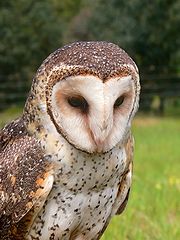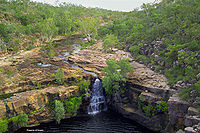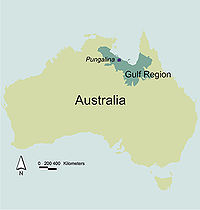
Pungalina-Seven Emu Sanctuary
Encyclopedia
Pungalina-Seven Emu Sanctuary is a 3060 km2 nature reserve
in the Northern Territory
of Australia
. It is managed by the Australian Wildlife Conservancy
(AWC) which purchased Pungalina Station in 2009, with some assistance from the Wildlife Australia Fund
. It adjoins the Gulf of Carpentaria
near the border with Queensland
, lying in the Gulf Coastal bioregion. The reserve is bordered by Calvert Hills and Wollogorang Stations to the south and east. The nearest town is Borroloola
, 150 km to the west.
, Pungalina and Seven Emu. Pungalina is a former cattle station
while Seven Emu is owned by a Garawa
man, Frank Shadforth, who has subleased 110,000 ha of the property to AWC for wildlife conservation. Seven Emu has 55 km of coastline and links Pungalina to the coast. The arrangement is a historic partnership between a non-profit, private conservation organization and an indigenous
landholder.
 The Gulf Coastal bioregion is characterised by:
The Gulf Coastal bioregion is characterised by:
The reserve contains a variety of habitat types including, from south to north, eucalypt
woodlands on sandstone plateau
s with pockets of dry rainforest in deep gorges, floodplain
woodland
s and freshwater
wetland
s, coastal monsoon rainforest
, littoral
saline grassland
s, mangrove
s, and intertidal mudflat
s. There is an abrupt transition, marked by an escarpment, between the plateau and the floodplain. The Calvert River
drains the dissected plateau country through a network of steep-sided gorges and flows north-eastwards through the lowlands of the reserve before emptying into the Gulf of Carpentaria.



, Red Goshawk
, Gouldian Finch
, Carpentarian False Antechinus, Freshwater Sawfish
, Mertens' Water Monitor
and Gulf Snapping Turtle
. Other birds and mammals recorded include the Purple-crowned Fairy-wren
, Australian Bustard
, Short-eared Rock-wallaby
, Spectacled Hare-wallaby
and Northern Brown Bandicoot
. Marine species recorded off the beach include Indo-Pacific Humpback Dolphin, Loggerhead Turtle, Green Turtle, Shovelnose Shark and Giant Trevally
, as well as Saltwater Crocodile
s.
The coastal and subcoastal habitats of the southern Gulf region are not as well known ornithologically
as the Top End
to the west and the Cape York Peninsula
to the east, with several birds having gaps in their recorded ranges between the two areas. Birds recorded in the reserve during the survey that help fill the distributional gaps include the Pacific Baza
, Little Bronze-cuckoo
, Figbird
and White-breasted Whistler
.

Nature reserve
A nature reserve is a protected area of importance for wildlife, flora, fauna or features of geological or other special interest, which is reserved and managed for conservation and to provide special opportunities for study or research...
in the Northern Territory
Northern Territory
The Northern Territory is a federal territory of Australia, occupying much of the centre of the mainland continent, as well as the central northern regions...
of Australia
Australia
Australia , officially the Commonwealth of Australia, is a country in the Southern Hemisphere comprising the mainland of the Australian continent, the island of Tasmania, and numerous smaller islands in the Indian and Pacific Oceans. It is the world's sixth-largest country by total area...
. It is managed by the Australian Wildlife Conservancy
Australian Wildlife Conservancy
The Australian Wildlife Conservancy is an Australian independent, non-profit organisation, working to conserve threatened wildlife and ecosystems in Australia, principally through the acquisition of extensive areas of land on which to establish conservation reserves . These sanctuaries are...
(AWC) which purchased Pungalina Station in 2009, with some assistance from the Wildlife Australia Fund
Wildlife Australia Fund
Wildlife Australia Fund, Inc. is a United States based international charitable organization established for the conservation, research and restoration of the environment. It was established and founded by an American and is supported by Australian expatriates in New York...
. It adjoins the Gulf of Carpentaria
Gulf of Carpentaria
The Gulf of Carpentaria is a large, shallow sea enclosed on three sides by northern Australia and bounded on the north by the Arafura Sea...
near the border with Queensland
Queensland
Queensland is a state of Australia, occupying the north-eastern section of the mainland continent. It is bordered by the Northern Territory, South Australia and New South Wales to the west, south-west and south respectively. To the east, Queensland is bordered by the Coral Sea and Pacific Ocean...
, lying in the Gulf Coastal bioregion. The reserve is bordered by Calvert Hills and Wollogorang Stations to the south and east. The nearest town is Borroloola
Borroloola, Northern Territory
Borroloola is a town in the Northern Territory of Australia. It is located on the McArthur River, about 50 km upstream from the Gulf of Carpentaria. At the 2006 census, Borroloola had a population of 773, of whom 579 declared themselves indigenous....
, 150 km to the west.
History
The reserve is made up of two separate pastoral propertiesPastoral lease
A pastoral lease is Crown land that government allows to be leased, generally for the purposes of farming.-Australia:Pastoral leases exist in both Australian commonwealth law and state jurisdictions....
, Pungalina and Seven Emu. Pungalina is a former cattle station
Cattle station
Cattle station is an Australian term for a large farm , whose main activity is the rearing of cattle. In Australia, the owner of a cattle station is called a grazier...
while Seven Emu is owned by a Garawa
Garawa language
Garawa is a recently extinct Australian Aboriginal language of northern Australia.-Classification:...
man, Frank Shadforth, who has subleased 110,000 ha of the property to AWC for wildlife conservation. Seven Emu has 55 km of coastline and links Pungalina to the coast. The arrangement is a historic partnership between a non-profit, private conservation organization and an indigenous
Indigenous Australians
Indigenous Australians are the original inhabitants of the Australian continent and nearby islands. The Aboriginal Indigenous Australians migrated from the Indian continent around 75,000 to 100,000 years ago....
landholder.
Landscape and ecosystems

"...gently undulating coastal plains along the southern Gulf of Carpentaria from near the Roper RiverRoper RiverThe Roper River is one of the largest rivers in the Northern Territory, Australia, extending east for over 500 km to meet the sea in Limmen Bight on the Gulf of Carpentaria. It is navigable for about 145 km, until the tidal limit at Roper Bar, and forms the southern boundary of the region...
to near the Queensland border, with scattered rugged areas of ProterozoicProterozoicThe Proterozoic is a geological eon representing a period before the first abundant complex life on Earth. The name Proterozoic comes from the Greek "earlier life"...
sandstoneSandstoneSandstone is a sedimentary rock composed mainly of sand-sized minerals or rock grains.Most sandstone is composed of quartz and/or feldspar because these are the most common minerals in the Earth's crust. Like sand, sandstone may be any colour, but the most common colours are tan, brown, yellow,...
s. Soils are predominantly sandy red earths and shallow gravelly sands. The climate is tropicalTropical monsoon climateTropical monsoon climate, occasionally also known as a tropical wet climate or tropical monsoon and trade-wind littoral climate in climate classification, is a relatively rare type of climate that corresponds to the Köppen climate classification category "Am."Tropical monsoon climates have monthly...
with annual rainfall between 800 and 1200 mm, falling mostly between December and March; cycloneCycloneIn meteorology, a cyclone is an area of closed, circular fluid motion rotating in the same direction as the Earth. This is usually characterized by inward spiraling winds that rotate anticlockwise in the Northern Hemisphere and clockwise in the Southern Hemisphere of the Earth. Most large-scale...
s are a frequent phenomenon. The bioregion encompasses the lower reaches of many major rivers. EucalyptusEucalyptusEucalyptus is a diverse genus of flowering trees in the myrtle family, Myrtaceae. Members of the genus dominate the tree flora of Australia...
woodland with tussock or hummock grass understorey dominates the bioregion, with significant areas of tidal flats, mangroves and littoral grassland."
The reserve contains a variety of habitat types including, from south to north, eucalypt
Eucalypt
Eucalypts are woody plants belonging to three closely related genera:Eucalyptus, Corymbia and Angophora.In 1995 new evidence, largely genetic, indicated that some prominent Eucalyptus species were actually more closely related to Angophora than to the other eucalypts; they were split off into the...
woodlands on sandstone plateau
Plateau
In geology and earth science, a plateau , also called a high plain or tableland, is an area of highland, usually consisting of relatively flat terrain. A highly eroded plateau is called a dissected plateau...
s with pockets of dry rainforest in deep gorges, floodplain
Floodplain
A floodplain, or flood plain, is a flat or nearly flat land adjacent a stream or river that stretches from the banks of its channel to the base of the enclosing valley walls and experiences flooding during periods of high discharge...
woodland
Woodland
Ecologically, a woodland is a low-density forest forming open habitats with plenty of sunlight and limited shade. Woodlands may support an understory of shrubs and herbaceous plants including grasses. Woodland may form a transition to shrubland under drier conditions or during early stages of...
s and freshwater
Freshwater
Fresh water is naturally occurring water on the Earth's surface in ice sheets, ice caps, glaciers, bogs, ponds, lakes, rivers and streams, and underground as groundwater in aquifers and underground streams. Fresh water is generally characterized by having low concentrations of dissolved salts and...
wetland
Wetland
A wetland is an area of land whose soil is saturated with water either permanently or seasonally. Wetlands are categorised by their characteristic vegetation, which is adapted to these unique soil conditions....
s, coastal monsoon rainforest
Rainforest
Rainforests are forests characterized by high rainfall, with definitions based on a minimum normal annual rainfall of 1750-2000 mm...
, littoral
Littoral
The littoral zone is that part of a sea, lake or river that is close to the shore. In coastal environments the littoral zone extends from the high water mark, which is rarely inundated, to shoreline areas that are permanently submerged. It always includes this intertidal zone and is often used to...
saline grassland
Grassland
Grasslands are areas where the vegetation is dominated by grasses and other herbaceous plants . However, sedge and rush families can also be found. Grasslands occur naturally on all continents except Antarctica...
s, mangrove
Mangrove
Mangroves are various kinds of trees up to medium height and shrubs that grow in saline coastal sediment habitats in the tropics and subtropics – mainly between latitudes N and S...
s, and intertidal mudflat
Mudflat
Mudflats or mud flats, also known as tidal flats, are coastal wetlands that form when mud is deposited by tides or rivers. They are found in sheltered areas such as bays, bayous, lagoons, and estuaries. Mudflats may be viewed geologically as exposed layers of bay mud, resulting from deposition of...
s. There is an abrupt transition, marked by an escarpment, between the plateau and the floodplain. The Calvert River
Calvert River
The Calvert River is a river in the Northern Territory of Australia which flows into the Gulf of Carpentaria 150 km east of Borroloola, not far from the border with Queensland in the Gulf Coastal bioregion. Its annual outflow is about 1000 Gl...
drains the dissected plateau country through a network of steep-sided gorges and flows north-eastwards through the lowlands of the reserve before emptying into the Gulf of Carpentaria.



Fauna
An initial faunal survey in 2009 found over 231 vertebrate species present, including 19 native mammals, 151 birds and 61 kinds of reptiles and frogs, representing more than half of the nearly 430 native species that are predicted to occur on the reserve. Animals listed as threatened include the Masked OwlMasked Owl
The Australian Masked Owl is a barn owl of Southern New Guinea and the non-desert areas of Australia.-Taxonomy:Described subspecies of Tyto novaehollandiae include:* T. n. calabyi I.J. Mason, 1983,...
, Red Goshawk
Red Goshawk
The Red Goshawk is probably the rarest Australian bird of prey. It is found mainly in the savanna woodlands of northern Australia, particularly near watercourses...
, Gouldian Finch
Gouldian Finch
The Gouldian Finch, Erythrura gouldiae , also known as the Lady Gouldian Finch, Gould's Finch or the Rainbow Finch, is a colorful passerine bird endemic to Australia. There is strong evidence of a continuing decline, even at the best-known site near Katherine in the Northern Territory...
, Carpentarian False Antechinus, Freshwater Sawfish
Largetooth sawfish
The largetooth sawfish , also known as the Leichhardt's sawfish or freshwater sawfish, is a sawfish of the family Pristidae, found in shallow Indo-West Pacific oceans between latitudes 11° N and 39° S. As its relatives, it also enters freshwater. This critically endangered species reaches a length...
, Mertens' Water Monitor
Mertens' Water Monitor
Mertens’ Water Monitor , often misspelled Merten’s Water Monitor, is a member of the monitor lizard family found in northern Australia, and is a wide-ranging, active foraging, opportunistic predator of aquatic and riparian habitats. It is named after German herpetologist Robert...
and Gulf Snapping Turtle
Gulf Snapping Turtle
The Gulf snapping turtle is a species of freshwater turtle in the Chelidae family. It is endemic to Australia.-Taxonomy:...
. Other birds and mammals recorded include the Purple-crowned Fairy-wren
Purple-crowned Fairy-wren
The Purple-crowned Fairywren is a species of bird in the Maluridae family.It is endemic to northern Australia; two subspecies are recognized....
, Australian Bustard
Australian Bustard
The Australian Bustard, Ardeotis australis, is a large ground bird of grassland, woodland and open agricultural country across northern Australia and southern New Guinea. It is also commonly referred to in Central Australia as the Bush Turkey, particularly by Aboriginal people.The male is up to ...
, Short-eared Rock-wallaby
Short-eared Rock-wallaby
The Short-eared Rock-wallaby is a species of rock-wallaby found in northern Australia, in the northernmost parts of Northern Territory and Western Australia...
, Spectacled Hare-wallaby
Spectacled Hare-wallaby
The Spectacled Hare-wallaby is a species of macropod found in Australia and New Guinea. In Australia, a small sub-population is found on Barrow Island, while the mainland type is widespread, though in decline, across northern regions of the country.-Description:A species of Lagorchestes,...
and Northern Brown Bandicoot
Northern Brown Bandicoot
The Northern Brown Bandicoot , a marsupial species, is a bandicoot found only on the northern and eastern coasts of Australia and nearby islands, mainly Papua New Guinea. It is not, however, found far inland....
. Marine species recorded off the beach include Indo-Pacific Humpback Dolphin, Loggerhead Turtle, Green Turtle, Shovelnose Shark and Giant Trevally
Giant trevally
The giant trevally, Caranx ignobilis , is a species of large marine fish classified in the jack family, Carangidae...
, as well as Saltwater Crocodile
Saltwater Crocodile
The saltwater crocodile, also known as estuarine or Indo-Pacific crocodile, is the largest of all living reptiles...
s.
The coastal and subcoastal habitats of the southern Gulf region are not as well known ornithologically
Ornithology
Ornithology is a branch of zoology that concerns the study of birds. Several aspects of ornithology differ from related disciplines, due partly to the high visibility and the aesthetic appeal of birds...
as the Top End
Top End
The Top End of northern Australia is the second northernmost point on the continent. It covers a rather vaguely-defined area of perhaps 400,000 square kilometres behind the northern coast from the Northern Territory capital of Darwin across to Arnhem Land with the Indian Ocean on the west, the...
to the west and the Cape York Peninsula
Cape York Peninsula
Cape York Peninsula is a large remote peninsula located in Far North Queensland at the tip of the state of Queensland, Australia, the largest unspoilt wilderness in northern Australia and one of the last remaining wilderness areas on Earth...
to the east, with several birds having gaps in their recorded ranges between the two areas. Birds recorded in the reserve during the survey that help fill the distributional gaps include the Pacific Baza
Pacific Baza
The Pacific Baza, Aviceda subcristata, also known as the Crested Hawk, is a slender, medium-sized hawk with a distinctive crest. Its upperside is mainly dark brown, with a grey head and yellow eyes. It is conspicuously barred white and dark brown on the breast and on the underside of the tail and...
, Little Bronze-cuckoo
Little Bronze-Cuckoo
The Little Bronze Cuckoo is a species of cuckoo in the Cuculidae family.It is found in Australia, Cambodia, Indonesia, Malaysia, Papua New Guinea, Singapore, Thailand, and Vietnam....
, Figbird
Figbird
The figbirds are a genus of orioles found in wooded habitats in Australia, Papua New Guinea and the Lesser Sundas. The three species have been considered conspecific, but today all major authorities consider them as separate species. The split is primarily based on differences in measurements and...
and White-breasted Whistler
White-breasted Whistler
The White-breasted Whistler is a species of bird in the Pachycephalidae family.It is endemic to Australia.Its natural habitat is subtropical or tropical mangrove forests.-References:...
.
External links


